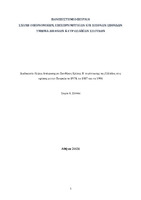Διαδικασία λήψεως αποφάσεων σε συνθήκες κρίσης. Η περίπτωση της Ελλάδας στις κρίσεις με την Τουρκία το 1974, το 1987 και το 1996

Προβολή/
Λέξεις κλειδιά
Λήψη απόφασης ; Διαχείριση κρίσεων ; Ελλάδα ; Τουρκία ; Decision making ; Crisis management ; Greece ; TurkeyΠερίληψη
Βασικός σκοπός της μελέτης είναι η κατανόηση και εξήγηση για το πως ένα μικρό κράτος, η Ελλάδα στην προκειμένη περίπτωση, λαμβάνει αποφάσεις, προκειμένου να αντιμετωπίσει μία κρίση στο πεδίο της εξωτερικής πολιτικής. Ο ανωτέρω προβληματισμός διατυπωμένος με το «πως ένα κράτος αποφασίζει» αφορά αφενός στο ποιος ή ποιοι είναι αυτοί που αποφασίζουν κάθε φορά εντός του κράτους, ποια είναι δηλαδή η μονάδα λήψης απόφασης - είναι ο ηγέτης ο τελικός αποφασίζων, είναι μια μικρή ομάδα με την οποία αποφασίζουν από κοινού, υπάρχει κάποιος άλλος σχηματισμός - και αφετέρου σε κάθε περίπτωση πως αυτοί αποφασίζουν κι αν υπόκεινται σε περιορισμούς τόσο αναφορικά με το εύρος των επιλογών τους όσο και ως προς το γιατί και πώς αποφασίζουν μια συγκεκριμένη επιλογή. Επιχειρείται, δηλαδή, η κατανόηση της στάσης της χώρας σε πολύ συγκεκριμένες περιπτώσεις, υπό συνθήκες απειλής ή ευκαιρίας και η εξεύρεση και παρατήρηση των λεπτομερειών και των περιορισμών κατά τον σχηματισμό της συμπεριφοράς της.
Η ανάλυση γίνεται υπό τη θεωρία του νεοκλασικού ρεαλισμού, η οποία δίνοντας έμφαση τόσο στο εξωτερικό ερέθισμα που κάθε κράτος δέχεται από το διεθνές σύστημα-ανεξάρτητη μεταβλητή, όσο και στις εσωτερικές εντός του κράτους διαδικασίες διαμόρφωσης της συμπεριφοράς του-παρεμβαλλόμενες μεταβλητές, καταφέρνει να δώσει πλήρη εικόνα και ικανοποιητικές εξηγήσεις, αναφορικά με τη στάση και τις αποφάσεις των κρατών σε συγκεκριμένες περιπτώσεις και καταστάσεις.
Οι περιπτώσεις, οι οποίες μελετώνται αφορούν στα περιστατικά κρίσης της Ελλάδας με την Τουρκία, το 1974 με την εισβολή στην Κύπρο, το 1987 στο Αιγαίο και το 1996 στα Ίμια. Κάθε περίπτωση κρίσης με τα βασικά προσδιοριστικά χαρακτηριστικά της, τα οποία είναι η απειλή σε βασική αξία, ο περιορισμένος χρόνος αντίδρασης και η αυξημένη πιθανότητα εμπλοκής σε πόλεμο, αποτελεί μία ιδιαιτέρως απαιτητική κατάσταση, στην οποία τα κράτη καλούνται πολύ γρήγορα να αντιδράσουν, να αποφασίσουν και να διαμορφώσουν τη συμπεριφορά τους. Και σύμφωνα με τη βασική υπόθεση της μελέτης κάθε κράτος που καλείται να αντιδράσει και να αποφασίσει κάτω από τέτοιες καταστάσεις, περιορίζεται, ως προς τις διαθέσιμες επιλογές, καταρχάς από τη δομή του διεθνούς συστήματος και στη συνέχεια από ενδεχόμενους γνωσιακούς περιορισμούς των εμπλεκόμενων στη λήψη των αποφάσεων, δηλαδή μεμονωμένων ατόμων, μικρών ομάδων και της γραφειοκρατίας.
Η διατριβή λαμβάνοντας υπόψη την ανάλυση όλων των ανωτέρω καταλήγει στο γενικό συμπέρασμα πως πράγματι η δομή του διεθνούς συστήματος δημιουργεί για τα κράτη ένα εύρος επιλογών και αποφάσεων και με αυτόν τον τρόπο θέτει το γενικό πλαίσιο συμπεριφοράς, εκτός του οποίου τα κράτη υφίστανται συνέπειες. Ωστόσο, όπως υποστηρίζεται από τον Waltz, το πλαίσιο θέτει μεν τα όρια, αλλά σε καμία περίπτωση δεν δύναται να καθορίσει με ακρίβεια τη διαμορφούμενη συμπεριφορά. Οι συγκεκριμένες αποφάσεις και ενέργειες καθορίζονται και επιλέγονται από το υποσύστημα των ατόμων, των ομάδων και της γραφειοκρατίας κάθε κράτους. Ωστόσο, τα επιμέρους αυτά υποσυστήματα πολλές φορές πάσχουν από γνωστικούς περιορισμούς, οι οποίοι επηρεάζουν την ποιότητα των αποφάσεων, των επιλογών και τη διαμορφούμενη αντίδραση, η οποία δύναται να είναι από καλή, πολύ καλή ή βέλτιστη και σε κάθε περίπτωση αποδεκτή συμπεριφορά και εντός του πλαισίου του διεθνούς συστήματος έως μια μη αποδεκτή συμπεριφορά και εκτός εξωτερικών ορίων αυτού, με αναμενόμενες συνέπειες για το κράτος που την έχει επιλέξει.
Αναφορικά με τις τρεις περιπτώσεις κρίσεων που μελετήθηκαν, το 1974 το υποσύστημα των ατόμων και της ομάδας της χώρας λειτούργησε κάτω από σημαντικούς γνωστικούς περιορισμούς, οι οποίοι επηρέασαν τη λήψη των αποφάσεων. Η ελληνική πλευρά αντιλήφθηκε λανθασμένα την ύπαρξη ευκαιρίας εντός του διεθνούς συστήματος, αυτήν της ένωσης της Ελλάδας με την Κύπρο. Ωστόσο, η επιλογή αυτή δεν ήταν σε καμία περίπτωση μια καθαρή ευκαιρία για την Ελλάδα, η οποία απλώς υπερεκτίμησε τις δυνάμεις της και άρα δεν συμπεριφέρθηκε σύμφωνα με τη θέση της, την ικανότητά της και την πραγματική της ισχύ σε σχέση με το διεθνές σύστημα, ενώ ταυτόχρονα υπολόγισε και απολύτως λάθος τις αντιδράσεις του αντιπάλου της, της Τουρκίας στην προκειμένη περίπτωση.
Όσον αφορά στο περιστατικό της κρίσης στο Αιγαίο τον Μάρτιο του 1987, οι αποφάσεις ελήφθησαν συντονισμένα από το υποσύστημα των παρεμβαλλόμενων μεταβλητών, της γραφειοκρατίας, των μικρών ομάδων και των μεμονωμένων ατόμων. Το μήνυμα και οι πληροφορίες γύρω από την τουρκική απειλή ήταν καθαρά και σαφή και παράλληλα εκλήφθηκαν ως τέτοια από τους υπεύθυνους της λήψης των αποφάσεων. Παρατηρήθηκε, δηλαδή, πως κατά τη λήψη των κρίσιμων αποφάσεων δεν υπήρξαν σημαντικοί περιορισμοί ούτε από τη λειτουργία της γραφειοκρατίας ούτε από τις μικρές ομάδες και τα μεμονωμένα άτομα, οι οποίοι όλοι μαζί ενήργησαν συντονισμένα, εναρμονισμένα και εντός του πλαισίου διαμορφούμενης συμπεριφοράς από τη δομή του διεθνούς συστήματος. Έτσι επιλέχθηκε η αντιμετώπιση της απειλής με την εξισορρόπηση του αντιπάλου και την επαναφορά της ισορροπίας ισχύος με τη χρήση των διαθέσιμων μέσων που η Ελλάδα είχε εκείνη τη στιγμή στη διάθεσή της και αφορούσαν στην εσωτερική και εξωτερική κινητοποίηση.
Τέλος, όσον αφορά στο τρίτο και τελευταίο περιστατικό που μελετήθηκε, αυτό της κρίσης των Ιμίων το 1996, πρόκειται για περίπτωση ύπαρξης καθαρής απειλής. Ωστόσο, στην προκειμένη περίπτωση κρίσης διαπιστώνονται προβλήματα κατά τη λειτουργία των επιμέρους υποσυστημάτων λήψης των αποφάσεων, όπου παρατηρείται σημαντική καθυστέρηση, από τα αρμόδια μεμονωμένα άτομα, την ομάδα και τη γραφειοκρατία, αντίληψης της καθαρής απειλής και ως εκ τούτου αντίστοιχη καθυστέρηση στην απαιτούμενη αντίδραση και έλλειψη συντονισμού και ευθυγραμμισμένης και κοινής πορείας δράσης απέναντι στην τουρκική απειλή. Η διαμορφούμενη συμπεριφορά θεωρείται αποδεκτή και εντός του πλαισίου στάση, αλλά σίγουρα δεν ήταν η καλύτερη επιλογή, καθώς απεφεύχθη από τη μία ο πόλεμος, από την άλλη όμως δεν κατάφερε η Ελλάδα να εξισορροπήσει και να αποτρέψει τον αντίπαλό της, την Τουρκία, από τις επιδιώξεις και τις διεκδικητικές της θέσεις.

